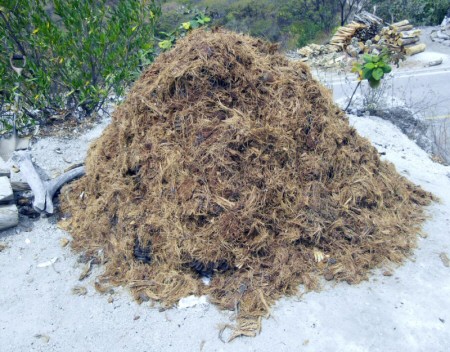
Fiber discarded from still ready for other uses
|
 Fiber discarded from still ready for other uses
|
Oaxaca is the state in southern Mexico which produces most of the country's mezcal (also referred to as mescal), the spirit derived from the agave or maguey plant. While over the past few years drinking mezcal made with different varieties of agave has become in vogue, such as in a select number of American markets, as well as in Mexico City and of course Oaxaca, it's agave espadín which is still used to make well over 90% of the mezcal produced in Mexico. Espadín is easy to cultivate, and a single plant is capable of producing a heart or piña (the part of the plant which is baked, fermented and distilled) which weighs up to 400 pounds.
If an agave espadín is earmarked for reproduction, at maturity the quiote is permitted to shoot up, extending up to 20 feet, reaching towards the heavens while producing up to 200 baby plants. The tiny agave are harvested. They can then be left untended for months while remaining viable for growth. After planting they require periodic watering for the first year or two, but if during the rainy season they are transplanted from their small starter beds into the fields, they require no further irrigation for the ensuing six to eight years; at which time they are mature and ready for harvest. Water is a scarce resource in most districts of Oaxaca, so the cultivation of a plant with no watering requirements after its initial growth stage is a gift from the gods.
It's not only the quiote which can be used as fuel. When the agave is harvested its leaves are cut off and have no further direct use in the mezcal making process. However, once dried they too are used to fuel pottery ovens and for cooking. They can also be used to make rope (ixtle, similar to hemp), woven into mats, employed as a needle and thread, processed into a green dye, and the list goes on. The leaves from pulquero varieties of agave (aguamiel [honey water] is naturally produced by these large, majestic agave, which ferments into the pre-Hispanic drink, pulque) are often used to add flavor when goat, sheep and beef are baked the traditional way in a sealed, in-ground oven over firewood and rocks.
The jury's still out as to whether fueling ovens for baking agave using firewood as opposed to a fossil fuel such as diesel or propane, is more environmentally friendly. But true artisanal mezcal continues to utilize firewood for cooking the agave, as well as for its distillation. The firewood can come from several kinds of tree. Second and third quality logs from the forestry industry which are preferably not used in home construction or for other uses requiring better grade lumber, are used as fuel for making mezcal. Similarly, the branches of dead, rotting trees found in fields and forests can be used as firewood in certain stages of the mezcal making process, such as for kindling.
The agave is baked in a sealed earthen pit over rocks piled atop the firewood. After about five days the agave is ready to be removed from this rudimentary oven. It's not ash which remains at the bottom of the pit, but rather charcoal. The charcoal is either sold commercially or used by the family of the palenquero (mezcal producer) for cooking - including making tortillas with masa made from corn, and yes the quiote of the agave. To this extent firewood used in this stage of the mezcal making process can be distinguished from commercially produced non - renewable energy sources.
After the carbohydrate rich baked agave is crushed, employing a beast of burden as custom dictates as opposed to motorized equipment, it's then fermented in large pine vats. The yeasts which work their magic are from the environment, rather than commercially produced. A relatively small amount of water is added, and fermentation continues for anywhere from seven days to two weeks depending on ambient temperature and other factors. The fermented liquid and crushed fiber are placed in a still, usually copper encased with stone or brick, and mud or cement as mortar.
Once the still has run its course and a batch of mezcal has been produced (generally mezcal is double distilled), there is waste; water and fiber which have had most of their nutritional value removed during distillation. The water is drained from the still and can be used for irrigating baby agave, or growing fruits or vegetables.
The fiber can be utilized as compost or mulch. When dry it can also be used as a fire starter. With the addition of mud and sand it can be employed to make adobe bricks. Adobe used to be the construction material of Mexico's indigenous poor, but it's now more expensive than clay brick and block, the middle classes having recognizing its insulation properties (particularly important during the country's hot times of year since the use of air conditioning is rare due to high hydro electricity costs), its pleasing aesthetics, and its significance within the context of sustainability.
Experimenting is under way utilizing the discarded fiber as the substratum for cultivating mushrooms, another important and sustainable industry taking hold in Oaxaca. With the passage of decades, no doubt additional uses for parts of agave espadín, by-products of the mezcal making process, will come to light, protecting Mexico's green environment for generations to come. When drinking true, artisanal mezcal, consider how you're supporting a green and sustainable Oaxacan industry.
Alvin Starkman takes couples and families to small, traditional roadside mezcal factories, and into the fields to harvest aguamiel. Alvin and his wife Arlene operate Casa Machaya Oaxaca Bed & Breakfast.